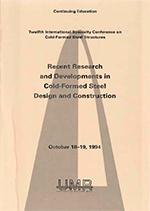Location
Saint Louis, Missouri
Session Dates
18 Oct 1994
Abstract
The paper describes a test program on welded stainless steel X- and K-joints fabricated from square hollow section brace members and chords. The X-joints were tested in compression and tension using different ratios of brace width to chord width. The K-joints were tested by varying the ratio of brace width to chord width, the angle between chord and brace members, and the preload applied to the chord. A total of 23 tests were performed. Design rules are proposed for X- and K-joints by adopting the rules of the CIDECT Recommendations for carbon steel tubular structures and replacing the yield stress in these recommendations by a proof stress. It is shown that the 0.2 % proof stress, as determined form the finished tube, can be used to determine the ultimate strength using the CIDECT design rules, and that the serviceability limit state corresponding to joint deformations of 1 % of the chord width will not be reached if the CIDECT strength rules are adopted. It is also shown that the CIDECT strength rules produce unconservative design strengths when using the 0.5 % proof stress in cases of high compressive forces in the chord. However, the serviceability limit state will generally not be reached if the 0.5 % proof stress is used.
Department(s)
Civil, Architectural and Environmental Engineering
Research Center/Lab(s)
Wei-Wen Yu Center for Cold-Formed Steel Structures
Meeting Name
12th International Specialty Conference on Cold-Formed Steel Structures
Publisher
University of Missouri--Rolla
Document Version
Final Version
Rights
© 1994 University of Missouri--Rolla, All rights reserved.
Document Type
Article - Conference proceedings
File Type
text
Language
English
Recommended Citation
Young, Ben and Rasmussen, Kim J. R., "Stainless Steel Tubular Joints - Tests and Design of X- and K-joints in Square Hollow Sections" (1994). CCFSS Proceedings of International Specialty Conference on Cold-Formed Steel Structures (1971 - 2018). 2.
https://scholarsmine.mst.edu/isccss/12iccfss/12iccfss-session9/2
Stainless Steel Tubular Joints - Tests and Design of X- and K-joints in Square Hollow Sections
Saint Louis, Missouri
The paper describes a test program on welded stainless steel X- and K-joints fabricated from square hollow section brace members and chords. The X-joints were tested in compression and tension using different ratios of brace width to chord width. The K-joints were tested by varying the ratio of brace width to chord width, the angle between chord and brace members, and the preload applied to the chord. A total of 23 tests were performed. Design rules are proposed for X- and K-joints by adopting the rules of the CIDECT Recommendations for carbon steel tubular structures and replacing the yield stress in these recommendations by a proof stress. It is shown that the 0.2 % proof stress, as determined form the finished tube, can be used to determine the ultimate strength using the CIDECT design rules, and that the serviceability limit state corresponding to joint deformations of 1 % of the chord width will not be reached if the CIDECT strength rules are adopted. It is also shown that the CIDECT strength rules produce unconservative design strengths when using the 0.5 % proof stress in cases of high compressive forces in the chord. However, the serviceability limit state will generally not be reached if the 0.5 % proof stress is used.



